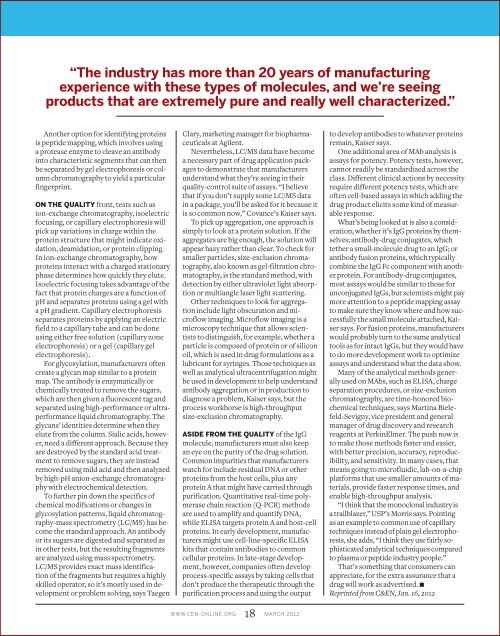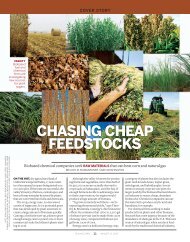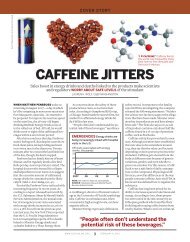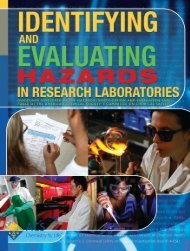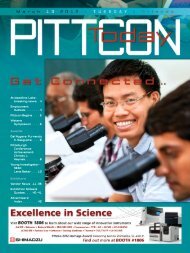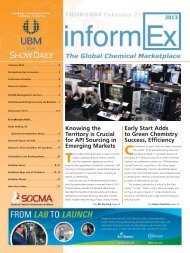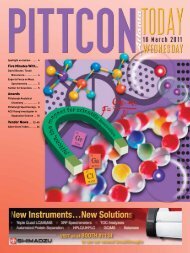focus on life sciences - Chemical & Engineering News - American ...
focus on life sciences - Chemical & Engineering News - American ...
focus on life sciences - Chemical & Engineering News - American ...
- No tags were found...
Create successful ePaper yourself
Turn your PDF publications into a flip-book with our unique Google optimized e-Paper software.
“The industry has more than 20 years of manufacturingexperience with these types of molecules, and we’re seeingproducts that are extremely pure and really well characterized.”Another opti<strong>on</strong> for identifying proteinsis peptide mapping, which involves usinga protease enzyme to cleave an antibodyinto characteristic segments that can thenbe separated by gel electrophoresis or columnchromatography to yield a particularfingerprint.ON THE QUALITY fr<strong>on</strong>t, tests such asi<strong>on</strong>-exchange chromatography, isoelectric<str<strong>on</strong>g>focus</str<strong>on</strong>g>ing, or capillary electrophoresis willpick up variati<strong>on</strong>s in charge within theprotein structure that might indicate oxidati<strong>on</strong>,deamidati<strong>on</strong>, or protein clipping.In i<strong>on</strong>-exchange chromatography, howproteins interact with a charged stati<strong>on</strong>aryphase determines how quickly they elute.Isoelectric <str<strong>on</strong>g>focus</str<strong>on</strong>g>ing takes advantage of thefact that protein charges are a functi<strong>on</strong> ofpH and separates proteins using a gel witha pH gradient. Capillary electrophoresisseparates proteins by applying an electricfield to a capillary tube and can be d<strong>on</strong>eusing either free soluti<strong>on</strong> (capillary z<strong>on</strong>eelectrophoresis) or a gel (capillary gelelectrophoresis).For glycosylati<strong>on</strong>, manufacturers oftencreate a glycan map similar to a proteinmap. The antibody is enzymatically orchemically treated to remove the sugars,which are then given a fluorescent tag andseparated using high-performance or ultraperformanceliquid chromatography. Theglycans’ identities determine when theyelute from the column. Sialic acids, however,need a different approach. Because theyare destroyed by the standard acid treatmentto remove sugars, they are insteadremoved using mild acid and then analyzedby high-pH ani<strong>on</strong>-exchange chromatographywith electrochemical detecti<strong>on</strong>.To further pin down the specifics ofchemical modificati<strong>on</strong>s or changes inglycosylati<strong>on</strong> patterns, liquid chromatography-massspectrometry (LC/MS) has becomethe standard approach. An antibodyor its sugars are digested and separated asin other tests, but the resulting fragmentsare analyzed using mass spectrometry.LC/MS provides exact mass identificati<strong>on</strong>of the fragments but requires a highlyskilled operator, so it’s mostly used in developmentor problem solving, says TaegenClary, marketing manager for biopharmaceuticalsat Agilent .Nevertheless, LC/MS data have becomea necessary part of drug applicati<strong>on</strong> packagesto dem<strong>on</strong>strate that manufacturersunderstand what they’re seeing in theirquality-c<strong>on</strong>trol suite of assays. “I believethat if you d<strong>on</strong>’t supply some LC/MS datain a package, you’ll be asked for it because itis so comm<strong>on</strong> now,” Covance’s Kaiser says.To pick up aggregati<strong>on</strong>, <strong>on</strong>e approach issimply to look at a protein soluti<strong>on</strong>. If theaggregates are big enough, the soluti<strong>on</strong> willappear hazy rather than clear. To check forsmaller particles, size-exclusi<strong>on</strong> chromatography,also known as gel-filtrati<strong>on</strong> chromatography,is the standard method, withdetecti<strong>on</strong> by either ultraviolet light absorpti<strong>on</strong>or multiangle laser light scattering.Other techniques to look for aggregati<strong>on</strong>include light obscurati<strong>on</strong> and microflowimaging. Microflow imaging is amicroscopy technique that allows scientiststo distinguish, for example, whether aparticle is composed of protein or of silic<strong>on</strong>oil, which is used in drug formulati<strong>on</strong>s as alubricant for syringes. Those techniques aswell as analytical ultracentrifugati<strong>on</strong> mightbe used in development to help understandantibody aggregati<strong>on</strong> or in producti<strong>on</strong> todiagnose a problem, Kaiser says, but theprocess workhorse is high-throughputsize-exclusi<strong>on</strong> chromatography.ASIDE FROM THE QUALITY of the IgGmolecule, manufacturers must also keepan eye <strong>on</strong> the purity of the drug soluti<strong>on</strong>.Comm<strong>on</strong> impurities that manufacturerswatch for include residual DNA or otherproteins from the host cells, plus anyprotein A that might have carried throughpurificati<strong>on</strong>. Quantitative real-time polymerasechain reacti<strong>on</strong> (Q-PCR) methodsare used to amplify and quantify DNA,while ELISA targets protein A and host-cellproteins. In early development, manufacturersmight use cell-line-specific ELISAkits that c<strong>on</strong>tain antibodies to comm<strong>on</strong>cellular proteins. In late-stage development,however, companies often developprocess-specific assays by taking cells thatd<strong>on</strong>’t produce the therapeutic through thepurificati<strong>on</strong> process and using the outputto develop antibodies to whatever proteinsremain, Kaiser says.One additi<strong>on</strong>al area of MAb analysis isassays for potency. Potency tests, however,cannot readily be standardized across theclass. Different clinical acti<strong>on</strong>s by necessityrequire different potency tests, which areoften cell-based assays in which adding thedrug product elicits some kind of measurableresp<strong>on</strong>se.What’s being looked at is also a c<strong>on</strong>siderati<strong>on</strong>,whether it’s IgG proteins by themselves;antibody-drug c<strong>on</strong>jugates, whichtether a small-molecule drug to an IgG; orantibody fusi<strong>on</strong> proteins, which typicallycombine the IgG Fc comp<strong>on</strong>ent with anotherprotein. For antibody-drug c<strong>on</strong>jugates,most assays would be similar to those forunc<strong>on</strong>jugated IgGs, but scientists might paymore attenti<strong>on</strong> to a peptide mapping assayto make sure they know where and how successfullythe small molecule attached, Kaisersays. For fusi<strong>on</strong> proteins, manufacturerswould probably turn to the same analyticaltools as for intact IgGs, but they would haveto do more development work to optimizeassays and understand what the data show.Many of the analytical methods generallyused <strong>on</strong> MAbs, such as ELISA, chargeseparati<strong>on</strong> procedures, or size-exclusi<strong>on</strong>chromatography, are time-h<strong>on</strong>ored biochemicaltechniques, says Martina Bielefeld-Sevigny, vice president and generalmanager of drug discovery and researchreagents at PerkinElmer . The push now isto make those methods faster and easier,with better precisi<strong>on</strong>, accuracy, reproducibility,and sensitivity. In many cases, thatmeans going to microfluidic, lab-<strong>on</strong>-a-chipplatforms that use smaller amounts of materials,provide faster resp<strong>on</strong>se times, andenable high-throughput analysis.“I think that the m<strong>on</strong>ocl<strong>on</strong>al industry isa trailblazer,” USP’s Morris says. Pointingas an example to comm<strong>on</strong> use of capillarytechniques instead of plain gel electrophoresis,she adds, “I think they use fairly sophisticatedanalytical techniques comparedto plasma or peptide industry people.”That’s something that c<strong>on</strong>sumers canappreciate, for the extra assurance that adrug will work as advertised. ◾Reprinted from C&EN, Jan. 16, 2012WWW.CEN-ONLINE.ORG 18 MARCH 2012


